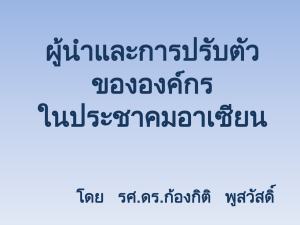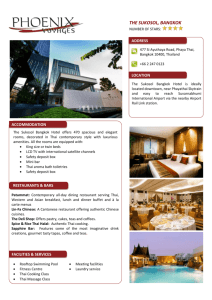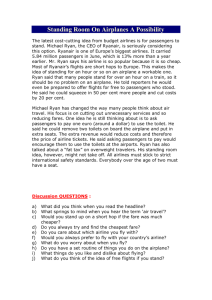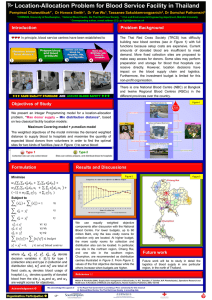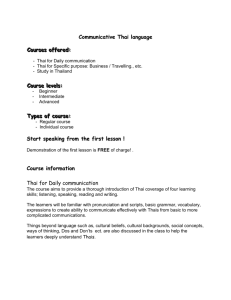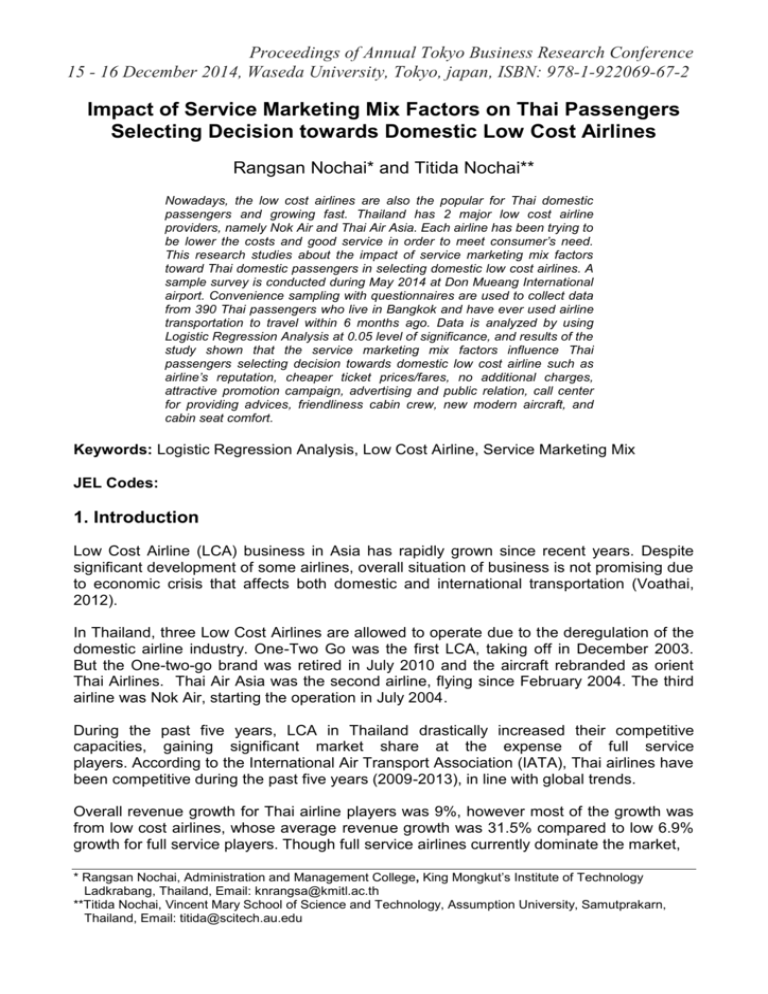
Proceedings of Annual Tokyo Business Research Conference
15 - 16 December 2014, Waseda University, Tokyo, japan, ISBN: 978-1-922069-67-2
Impact of Service Marketing Mix Factors on Thai Passengers
Selecting Decision towards Domestic Low Cost Airlines
Rangsan Nochai* and Titida Nochai**
Nowadays, the low cost airlines are also the popular for Thai domestic
passengers and growing fast. Thailand has 2 major low cost airline
providers, namely Nok Air and Thai Air Asia. Each airline has been trying to
be lower the costs and good service in order to meet consumer’s need.
This research studies about the impact of service marketing mix factors
toward Thai domestic passengers in selecting domestic low cost airlines. A
sample survey is conducted during May 2014 at Don Mueang International
airport. Convenience sampling with questionnaires are used to collect data
from 390 Thai passengers who live in Bangkok and have ever used airline
transportation to travel within 6 months ago. Data is analyzed by using
Logistic Regression Analysis at 0.05 level of significance, and results of the
study shown that the service marketing mix factors influence Thai
passengers selecting decision towards domestic low cost airline such as
airline’s reputation, cheaper ticket prices/fares, no additional charges,
attractive promotion campaign, advertising and public relation, call center
for providing advices, friendliness cabin crew, new modern aircraft, and
cabin seat comfort.
Keywords: Logistic Regression Analysis, Low Cost Airline, Service Marketing Mix
JEL Codes:
1. Introduction
Low Cost Airline (LCA) business in Asia has rapidly grown since recent years. Despite
significant development of some airlines, overall situation of business is not promising due
to economic crisis that affects both domestic and international transportation (Voathai,
2012).
In Thailand, three Low Cost Airlines are allowed to operate due to the deregulation of the
domestic airline industry. One-Two Go was the first LCA, taking off in December 2003.
But the One-two-go brand was retired in July 2010 and the aircraft rebranded as orient
Thai Airlines. Thai Air Asia was the second airline, flying since February 2004. The third
airline was Nok Air, starting the operation in July 2004.
During the past five years, LCA in Thailand drastically increased their competitive
capacities, gaining significant market share at the expense of full service
players. According to the International Air Transport Association (IATA), Thai airlines have
been competitive during the past five years (2009-2013), in line with global trends.
Overall revenue growth for Thai airline players was 9%, however most of the growth was
from low cost airlines, whose average revenue growth was 31.5% compared to low 6.9%
growth for full service players. Though full service airlines currently dominate the market,
* Rangsan Nochai, Administration and Management College, King Mongkut’s Institute of Technology
Ladkrabang, Thailand, Email: knrangsa@kmitl.ac.th
**Titida Nochai, Vincent Mary School of Science and Technology, Assumption University, Samutprakarn,
Thailand, Email: titida@scitech.au.edu
Proceedings of Annual Tokyo Business Research Conference
15 - 16 December 2014, Waseda University, Tokyo, japan, ISBN: 978-1-922069-67-2
LCA are growing rapidly and reaping market share from conventional players. In 2013, low
cost airlines held 46% of Thai airline market share (calculated from revenue received from
domestic routes), while full service airlines held 54%. Thai Airways, a full service airline,
still leads the market with the highest domestic market share at 31.6%, followed by Thai
Air Asia and Nok Air, Thai low cost airlines, at 23.2% and 22.7%. From a market share
growth perspective, during 2011-2013 low cost airlines' market share growth was 9%,
while full service airlines' market share growth dropped by 6%. The player with the highest
market share growth was Nok Air at 16.5% (Srisumran and Sintanabodee, 2014).
LCA become strategic move of airline business as companies reduce irrelevant expenses
such as crew uniform and in-flight catering so tickets can be offered at competitive price.
Moreover, tickets can be sold in advance via internet so company can efficiently manage
flight schedules and minimize risk of empty seats. Low cost airlines have always changed
marketing strategies to survive in the business and fulfill customers’ needs
(Charoensettasilp and Wu, 2013).
Each LCA needs their own business marketing strategy as marketing mix factors (product,
price, place, and promotion) but it is not enough to support airline to meet with success.
Therefore, business strategies focus on service marketing mix factors (product, price,
place, promotion, people, process, and physical evidence). People are the one of
essential ingredient to any service provision is the use of appropriate staff and people.
Process is the systems used to assist the organization in delivering the service and
Physical Evidence is the element of the service mix which allow the consumer to make
judgments for repurchase on the organization’s goods and services. These service
marketing mix factors are the factors that can lead the successful through the organization
(Nochai, 2013). Service marketing strategy is considered controllable factor that airlines
can apply to enhance customer satisfaction (Kotler, 2003).
Based on these reasons, this research will focus on a study of impact of service marketing
mix factors on Thai passengers selective decision towards domestic low cost airline; Nok
Air and Thai Air Asia, and to compare and analyze each factor of service marketing mix of
Thai passenger in relation to service of domestic low cost airlines. Research findings can
be applied as basic insights and guidelines for market planning to ensure fulfillment of
customer satisfaction and brand loyalty in the long run.
2. Literature Review
Different theories and models associated with the independent variables and dependent
variable will be reviewed to establish a conceptual framework of this research.
2.1 Service Marketing Mix Factors
Careful management of product, price, place, and promotion will clearly also be essential
to the successful marketing of services. However, the strategies for the 4Ps require some
modifications when applied to services because services are usually produced and
consumed simultaneously. Customers are often present in the firm’s factory, interact
directly with the firm’s personnel and are actually part of the service production process.
Further, services are intangible; customers will often be looking for any tangible cue to
help them understand the nature of the service experience (Zeithaml et al, 2006). The
common service marketing mix (7P’s) platforms are shown in Table 1.
Proceedings of Annual Tokyo Business Research Conference
15 - 16 December 2014, Waseda University, Tokyo, japan, ISBN: 978-1-922069-67-2
Table 1: Common Service Marketing Mix (7P’s) Platforms
Service Marketing Mix
Controllable variables
Factors
Product
Quality, Features, Options, Style, Packaging, Sizes, Services,
Returns, Warranties, and Brand
Price
List price, Discounts, Allowances, Payment period, Credit
terms, and Differentiate
Place
Channels, Coverage, Location, Inventory, Transport,
Intermediaries, and Managing channels
Promotion
Advertising, Personal Selling, Sales Promotion, Publicity, and
Internet/web strategy.
People
Service Provider, Customer being serviced, Other employees
and customers
Process
Policies & Procedures, Flow of activities, Number of steps,
Factory/Delivery cycle time, Training & Rewarding system, and
Customer involvement
Material used, Arrangement of objects, Lighting/Shadows,
Physical Evidence
Color, Temperature, Noise, and Other tangibles such as
reports, business cards, statement guarantees, etc.
Source: Zeithaml, Bitner, and Gremler, 2006, pp.26.
2.1.1 Product
A product can be an idea, a service, a goods or any combination of these three (Pride &
Ferrell, 1989). Product is defined as the goods-and-services combination the company
offers to the target market (Kotler & Armstrong, 2001). Moreover, product has various
variables such as product variety, quality, design, features, brand name, packaging, sizes,
warranties, returns (Kotler, 2003). Product is the first element of the marketing mix that
represents the basic offering being made to consumers, which consists of product variety,
quality, design, features, brand name, packaging, size, warranties, and returns (Kotler and
Keller, 2006).
2.1.2 Price
Price is defined as the amount of money or some product or service, given in exchange
for something in its price. In other word, price is exchanged for the product (Zikmund and
Amico, 1996). In term of marketing mix, price consists of list price, discounts, allowances,
payment period, and credit term, which marketers have to consider (Kotler & Keller, 2006).
Price is typically one of the important factors influencing demand for goods or service
(Teas and Agarwal, 2000). Moreover, price has a positive effect on perceived quality, but
negative effect on value to buy. When setting the price, the marketers have to consider
how consumer perceptions on price and how these perceptions affect consumers’
purchasing decision (Kent, 1996). A consumer compares products on cost and on utility
they expect to come from the product features (Assael, 1993).
Proceedings of Annual Tokyo Business Research Conference
15 - 16 December 2014, Waseda University, Tokyo, japan, ISBN: 978-1-922069-67-2
2.1.3 Place
Place is the marketer’s strategy for making a product available and can influence whether
and when customers encounter the product. A product that is widely available or easy to
buy will enter the consideration set of more consumers. Availability is especially important
for routine and limited decision making. The types of channels through which a product is
offered also influence consumers’ perception of the product’s image (Churchill and Peter,
1998).
2.1.4 Promotion
Promotion is about communicating with the consumer, and about persuading people to try
our product or service. In addition, it is usually much more concerned with attitude change.
Because attitudes are learned, promotional activities can offer new information to the
consumer. Promotion consists of sales promotion, advertising, sales force, public
relationship, and direct marketing (Kotler & Keller, 2006). The objective of promotion
strategies should be related the product to the consumer’s self-concept. If the promotion
strategy effectively connects the product information to consumers’ personal goal and
values, as well as, desired self-relevant consequences within the context of personal
situations, it will be perceived as personally relevant. Messages, which are personally
relevant, are more likelihood lead to increased interest, positive attitudes, positive
purchase intentions, and ultimately purchase behavior (Timothy, 1995).
2.1.5 People
People are an essential ingredient in service provision; recruiting and training the right
staff is required to create a competitive advantage. Customers make judgments about
service provision and delivery based on the people representing organization. People are
one of the few elements of the service that customers can see and interact with. Staffs
require appropriate interpersonal skills, attitude, and service knowledge in order to deliver
a quality service (learnmarketing.net, 2011).
2.1.6 Process
Process is the actual procedures, mechanisms, and flow of activities by which the goods
and services are delivered and are classified among operating systems. The actual
delivery steps that the customer experiences, or the operational flow of the service, also
give customers evidence on which to judge the goods and service (Zeithaml et al. 2006).
2.1.7 Physical Evidence
The physical environment of the service can clearly affect customer’s perceptions of their
service experience. The environmental dimensions of the service would include the
ambient conditions (temperature, air quality, noise, music, etc.) and the utilization of the
space (equipment, layout, furnishing), as well as any signs, symbols and artefacts
(Zeithaml et al, 2006).
Proceedings of Annual Tokyo Business Research Conference
15 - 16 December 2014, Waseda University, Tokyo, japan, ISBN: 978-1-922069-67-2
2.2 Service Marketing mix in airlines industry
Services are deeds, processes, and performance. Services are distinguished from
products mainly because they are generally produced at the same time as they are
consumed, and cannot be stored away or taken. An enhanced marketing mix needs to be
deployed. It’s not about simply reaching out to customers with the right service. But, it’s
also about creating that right desire to possess the service. 4P’s of marketing mix and
3P’s of Service Marketing Mix are
(1) Product mix --- design, quality, range, brand name, features which give a feel for
the “product” inside a service wrapper. Consumers are demanding not products, or
features of products but the benefits they will be offered. The airline product
includes of two types of service:
(a) On the ground services.
(b) In-Flight services.
(2) Price mix --- list price, discounts, commissions, surcharges, extras, premium
pricing, value for money pricing, cheap value pricing, low cost pricing, apex fares.
(3) Place mix --- distribution channels, methods of distribution, coverage, location,
online 24 hour reservation system, consolidation, tour operator/travel agent,
affiliated with companies.
(4) Promotion mix --- advertising, airlines advertisement need to keep in mind the
image of country, the scenic beauty, tourist attractions, rich cultural heritages or
which would attract number of tourists.
(a) Publicity, the pro, receptionist, travel agents, media people are very important
people in publicizing the business.
(b) Sales promotion, the travel agents, tour operators, frontline staffs contribute a
lot
to the promotion of airlines business.
(c) Salesmanship, word of mouth “Customer loyalty ladder”.
(5) People mix --- competence, reliability, caring attitude, responsiveness, Initiative,
problem solving ability, goodwill.
(6) Process mix --- reservation, flight information, facilities at the airport, baggage
handling, meal service, flight entertainment, deliver quality service.
(7) Physical evidence mix --- booking offices or ticket counter, paper work, brand logo,
Tickets, inflight: aircraft, seating configuration, good inner-exteriors, cleanliness,
uniforms, ambience, baggage, labels or tag (Ghosh, 2009).
2.3 Related research
Chayphan (2008) studied the relationships between servicing market factors and
passengers’ satisfaction with on board beverage service of Thai Airways International
Public Company Limited. The study reveals that overall opinion of passengers about on
board beverage service of Thai Airways International Public Company Limited and
servicing market factors such as Product, Price, Place, People and Physical Evidence are
highly agreed apart from promotion which overall is fairly agreed. Passengers’ satisfaction
with on board beverage service of Thai Airways International Public Company Limited is
high both for beverages and services. Comparison of passengers’ satisfactory level with
on board beverage service of Thai Airways International Public Company Limited
according to personal basic factors shows that passengers with different basic personal
factors such as gender, education, occupation and income have different levels of overall
satisfaction with on board beverage service of Thai Air- ways International Public
Company Limited at 5 percent significance level. Relationships between servicing market
Proceedings of Annual Tokyo Business Research Conference
15 - 16 December 2014, Waseda University, Tokyo, japan, ISBN: 978-1-922069-67-2
factors which consist of Product, Price, Place, Promotion, People, Physical Evidence and
Process and passengers’ satisfaction with on board beverage service of Thai Airways
International Public Company Limited are positively correlated at 5 percent significance
level in all aspects.
Sripromnil (2008) studied the factors on marketing mix affecting customers’ final decisions
on airline services of airport authority of Thailand cooperation in Muang district, Chiang
Mai. The study reveals that the customers’ final decisions were at a highest level in term
of the product and the staff’s services whereas their marketing promotion was at a lowest
level. As compared with each aspect, it was stated that airline reputation and imaged were
at a highest level in terms of the product. In terms of price, clarified airline tickets were at a
highest level. In terms of place, easy-to-buy airlines tickets were at highest level. In terms
of the marketing promotion, changeable flight schedules with no charge of fees were at a
highest level. In terms of the process, on-time schedules of embarking and landing flights
were at a highest level. In terms of the physical characteristics, modern airline equipments
were at a highest level. In terms of the staffs’ services, the staffs’ neat dressing, and their
service mind were at a highest level.
Charoensettasilp and Wu (2013) studied attitude and needs of Thai people in selecting
domestic low-cost airlines. 400 randomly selected samples include Thai people living in
Bangkok and used to travel by airlines. Research methodology includes random
convenience sampling technique that use questionnaire to gather data. At significance
level of 0.05, demo- graphic factors including gender, age, education level, monthly
income, and occupation do not affect attitude and needs of Thai people in selecting
domestic low-cost airlines. However, service marketing mix (7P’s) influence attitude and
needs of Thai people in selecting domestic low-cost airlines. Place mostly affects attitude
and needs of Thai people in selecting domestic low-cost airlines, following by Product,
People, Process, and Physical Evidence which demonstrate similar ranking, while Price
and Promotion are among the bottom ranking.
Snyder (2014) studied customer satisfaction at low cost airlines: A case study of Jetstar
Pacific Airlines (JPA) mentioned that the significant characteristics which are applied by
LCA to achieve the success will be described as follows:
(1) Fuel hedging: Fuel is one of the largest operating costs of airlines. When airlines
believe that the fuel price won’t drop in the future, they can sign a contract to buy for
a period of time at the current price. In the future, if the fuel price increase, they get
benefit, in contrast they paid the higher fuel prices.
(2) More seats: The LCA can sale the cheaper fare but they can still increase revenue
by arranging more passengers on the plane. For example, JPA reorganizes the
Boeing B737-400 aircraft configuration to accommodate 168 passengers, while
other FCA remains the configuration at 144 or 150 passenger seats.
(3) Pay for additional demands: LCA cuts off free food and drinks, instead of the
customer to pay for those services.
(4) Similar aircraft configuration: Using a unique aircraft type and configuration to
minimize the cost of training, maintenance, and repair.
(5) Using cheaper airport: They use the small airport, little attention therefore the cost of
parking and related services are lower.
(6) Online ticket: LCA sells tickets online or over the phone. It helps reduce the
marketing cost, agent commission cost, and ticket printing cost.
Proceedings of Annual Tokyo Business Research Conference
15 - 16 December 2014, Waseda University, Tokyo, japan, ISBN: 978-1-922069-67-2
(7) Flexible ticket prices: The ticket prices are extremely flexible, which is offered
depending on the needs of passengers. Normally, the sooner buying the ticket, the
lower price will be applied and as close to departure, the higher ticket price. Some
time the cheap ticket at the last minute when the aircraft has a lot of available seats.
(8) Short turnaround time: Reduce the ground time and increase flight time will be a
considerable cost savings for airlines. Adapting this aspect, LCA implements
appropriate solution. For example, pilots perform transit check; cabin crews carry out
cleaning job; aircraft interior is simply furnished and equipped leather seat covers for
easy cleaning; etc.
3.4 Logistic Regression Analysis
Logistic Regression allows us to predict a discrete outcome, such as group membership,
from a set of variables. Generally, the dependent variable in logistic regression is
categorical variable. Logistic regression estimates the odds of a certain event occurring
(Garson, 2009). Logistic regression makes no assumption about the distribution of the
independent variables. The relationship between the independents and dependent
variable is not a linear function. The logistic response function is
P (Y 1)
e
β0 β1X1 βpXp
1 e
β0 β1X1 βpXp
, where
i are logistic coefficients to be estimated; i =1, 2, …, p
For logistic regression, the "parameter estimate" is the B coefficient used to predict the log
odds (logit) of the dependent variable. The B coefficients with 0 indicate that the given
explanatory variable does not affect the logit (that is, makes no difference in the
probability of the dependent value equalling the value of the event, usually 1); positive or
negative B coefficients indicate the explanatory variable increases or decreases the logit
of the dependent. Exp (B) is the odds ratio for the explanatory variable. The odds ratio for
a given independent variable represents the factor by which the odds (event) change for a
one-unit change in the independent variable. An Exp (B) > 1 means the independent
variable increases odds (event). An Exp (B) < 1, then the independent variable decreases
odds (event).
Thus, the suggestion for considering the influential factor that has the effect on the
dependent variable is the influential factor(s) which has the statistically significance at the
level of significance ( ) with the value of Exp (B) > 1(Garson, 2009) should be considered
in the first priority and so on.
3. The Methodology and Model
3.1 The Model
According to the literature review, the research model is formed as shown in Figure 1.
The thirty alternative hypotheses are as follows:
Proceedings of Annual Tokyo Business Research Conference
15 - 16 December 2014, Waseda University, Tokyo, japan, ISBN: 978-1-922069-67-2
Ha1i: Products have the impact on Thai passengers selecting decision towards
domestic LCA, i = 1, 2, 3, 4
Ha2i: Prices have the impact on Thai passengers selecting decision towards
domestic LCA, i = 1, 2, 3, 4
Ha3i: Places have the impact on Thai passengers selecting decision towards
domestic LCA, i = 1, 2, 3, 4
Ha4i: Promotions have the impact on Thai passengers selecting decision towards
domestic LCA, i = 1, 2, 3, 4
Ha5i: People have the impact on Thai passengers selecting decision towards
domestic LCA, i = 1, 2, 3, 4
Ha6i: Processes have the impact on Thai passengers selecting decision towards
domestic LCA, i = 1, 2, 3, 4
Ha7i: Physical evidences have the impact on Thai passengers selecting decision towards
domestic LCA, i = 1, 2, 3, 4
Product
Price
Place
Promotion
People
Process
Physical
Evidence
Independent Variables
X1: airline’s reputation
X2: comfortable, safety and secure
X3: available flights schedule
X4: available routes and destinations
X5: suitable ticket prices and fares
X6: cheaper ticket prices and fares
X7: clarity of ticket price and fares
information
X8: no additional charges
X9: various ticket channel distributions
X10: ease of ticket purchase
X11: ease of reservation via website
X12: various payment methods
X13: attractive sale promotion campaign
X14: advertising and public relation
X15: website for providing informations
X16: call center for providing advices
X17: friendliness of cabin crew
X18: friendliness of ground staffs
X19: cabin crew/staffs presence thru flight
X20: professionalism of captain
X21: speed of check-in process
X22: flight’s punctuality
X23: speed of baggage delivery
X24: assistance during boarding
X25: new modern aircraft
X26: beautiful interior cabin/aircraft
X27: cabin cleanliness
X28: cabin seat comfort
X29: toilet cleanliness
X30: staff grooming
Hypotheses
Ha11
to
Ha14
Ha21
to
Ha24
Ha31
to
Ha34
Dependent
Variable
Ha41
to
Ha44
Passengers
selecting
decision
Ha51
to
Ha54
1. Nok Air
Ha61
to
Ha64
Ha71
to
Ha76
Figure 1: A Research Model
2. Thai Air Asia
Proceedings of Annual Tokyo Business Research Conference
15 - 16 December 2014, Waseda University, Tokyo, japan, ISBN: 978-1-922069-67-2
3.2 The Methodology
This research is a survey research; convenience sampling is used in collecting the sample
data. Pre-test is conducted and measures the reliability with Cronbach’s Alpha coefficient
in order to determine the reliability of the instrument used. The values of Cronbach’s
Alpha coefficient from 0.6 to 0.7 are considered as the acceptable level for reliability
measure. The overall Cronbach’s Alpha coefficient of this survey instrument is 0.78,
questionnaires are guaranteed that it is the good tool for data collecting. The
questionnaires are distributed to Thai passengers who live in Bangkok and have ever
used the service of airline transportation to travel within 6 months ago. A sample survey is
conducted during May 2014 at Don Mueang International airport among top two LCA in
Bangkok area. A total of 390 respondents are participated in this research. Binary Logistic
Regression Analysis is employed to obtain the important service marketing mix factors
affecting on Thai passengers’ decision towards selection of top two LCA.
4. The Findings
The data are analyzed and summarized with a Statistical package. Research findings are
divided into 2 parts:
Part 1: Demographic factors of respondents, using descriptive statistics.
Part 2: Hypothesis testing, using Binary logistic regression analysis at the level of
significance 0.05, the results are presented as follows:
Part 1: Demographic factors of respondents
Based on the results from data analysis shows that proportions of Thai female and male
respondents are 60.0% and 40.0% respectively; most of them are in age range of 15 - 25
years, 31.0% while proportions of 26 - 35, 36 - 45 and over 45 years are 29.23%, 17.95%,
and 21.79% respectively. Most respondents earned Bachelor degree at 69.49% while
percentages of education which is higher and lower than Bachelor degree are 21.54% and
8.97%. Proportions of monthly income in range of 0 - 15,000 Baht, 15,001 - 30,000,
30,001 - 45,000, 45,001 - 60,000, and over 60,000 Baht are 23.59%, 38.72%, 16.15%,
10.26%, and 11.28% respectively. Proportions of occupations are state enterprise and
government officer, employee, private firm/business owner, students, and others
(housewife/retired) are 29.23%, 23.85%, 23.59%,18.97% and 4.36% respectively.
Part 2: Hypothesis testing, using Binary logistic regression analysis
Based on 7P’s of service marketing mix, there are five important service marketing mix
factors affecting on Thai passengers’ decision towards domestic low cost airlines selection
are as follows: product – “airline’s reputation”, price --- “cheaper ticket prices/fares” and
“no additional charges”, promotion --- “attractive promotion campaign”, “advertising/public
relation”, and “call center for providing advices”, people --- “friendliness of cabin crew”,
and physical evidence --- “new modern aircraft” and “cabin seat comfort” (Table 2).
Comparing the Exp (B) value of Nok Air and Thai Air Asia from maximum thru minimum
value indicate that for factors “friendliness of cabin crew (1.9599)”, “call center for
providing advices (1.6889)”, “no additional charges (1.6090)”, “airline’s reputation
Proceedings of Annual Tokyo Business Research Conference
15 - 16 December 2014, Waseda University, Tokyo, japan, ISBN: 978-1-922069-67-2
(1.4810), and “cabin seat comfort (1.4723)”, Nok Air has the greater value of Exp (B) than
Thai Air Asia. It states that these factors are more likely influence Thai passengers in
selection of service of Nok Air than Air Asia.
Table 2: Summary table of parameter estimates for comparing factors between
Nok Air and Thai Air Asia
Nok Air
Factors
B
Thai Air Asia
Sig.
Exp(B)
*
0.0720
1.4810
**
0.0376
0.6526
B
Sig.
Exp(B)
*
0.0720
0.6752
**
0.0376
1.5324
**
Product
X1: airline’s reputation
0.3927
*
-0.3927
**
0.4268
**
*
Price
**
X6: cheaper ticket prices and fares
-0.4268
X8: no additional charges
0.4756
**
0.0043
1.6090
-0.4756
0.0043
0.6215
X13: attractive promotion campaign
-0.3750*
0.0773
0.6873*
0.3750*
0.0773
1.4550*
X14: advertising and public relation
-0.7032**
0.0012
0.4950**
0.7032**
0.0012
2.0203**
X16: call center for providing advices
0.5241**
0.0146
1.6889**
0.5241**
0.0146
0.5921**
0.6729**
0.0116
1.9599**
0.6729**
0.0116
0.5102**
X25: new modern aircraft
-0.4303*
0.0953
0.6503*
0.4303*
0.0953
1.5377*
X28: cabin seat comfort
0.3868*
0.0613
1.4723*
-0.3868*
0.0613
0.6792*
**
Promotion
People
X17: friendliness of cabin crew
Physical Evidence
Remarks: 1. * means the significance at 0.10 level of significance
2. ** means the significance at 0.05 level of significance
Similarly, it indicate that Thai Air Asia has the greater value of Exp (B) than Nok Air for
factors “advertising and public relation (2.0203)”, “new modern aircraft (1.5377)”, “cheaper
ticket prices/fares (1.5324)”, and “attractive sale promotion campaign (1.4555)”. It stated
that these factors are more likely influence Thai passengers in selection of service of Air
Asia than Nok Air.
5. Summary and Conclusions
According to the results, LCA in the study should focus on the service marketing mix
factors in order to increase the customer base and make more market share in this
segmentation as follow.
Nok Air should maintain the friendliness of cabin crew, providing call center for advising of
passengers, no additional charges but should set the limitation(s) of baggage weights.
Moreover, Nok Air should maintain in famous of airline continually and include having the
cabin seat comfort in all flights. Moreover, Nok Air should increase advertising and
attractive sale promotion campaign in order to increase the number of passengers in the
future.
.
Proceedings of Annual Tokyo Business Research Conference
15 - 16 December 2014, Waseda University, Tokyo, japan, ISBN: 978-1-922069-67-2
Due to Thai Air Asia, the ticket price is quite cheaper than Nok Air, has new modern
aircraft, and has the attractive sale promotion campaign continuously. Then Air Asia
should maintain these several points, and use it to be the strength point of the brand. Thai
Air Asia should set training program for their staff in providing good service/information
such as smile, and friendly with passengers in order to increase the impressive of
passengers in the future.
End Notes
The authors acknowledge the helpful comments of referees. This work was partially
supported by King Mongkut’s Institute of Technology Lardkrabang and Assumption
University, Bangkok, Thailand, we are very appreciative.
References
Assael, H 1993, Marketing: Principle and Strategies, (2nd ed.), Texas: Dryden.
Charoensettasilp, S and Wu, C 2013, Thai passengers’ satisfaction after receiving
services from Thailand's low cost airline, International Journal of u- and e- Service,
Science and Technology, Vol.6, No.6 (2013), pp.107-120.
Chayphan, N 2008, Relationships between Servicing Market Factors and Passengers’
Satisfaction with on Board Beverage Service of Thai Airways International Public
Company Limited, Phranakhon Rajabhat University, Bangkok.
Churchill, G A, Peter, J P 1998, Marketing: creating value for customers, Marketing
Research: methodological foundations.
Garson, G D 2009, Logistic Regression, retrieved from: http://faculty.chass.ncsu.edu
Ghosh, B 2009, Service-Marketing-Mix-in-Airindia, retrieved from: http://www.docstoc.com
Kent, B 1996, The effect of price, brand name and store name on buyers’ perceptions of
product, Journal of Marketing, Vol.21, pp.35-38.
Kotler, P and Armstrong, G 2001, Principles of Marketing. 9th ed, Prentice-Hall, New
Jersey.
Kotler, P 2003, Marketing Management, The Millennium Edition, Prentice-Hall, Upper
Saddle River.
Kotler, P and Keller, K L 2006, Marketing management, Pearson Prentice Hall, Upper
Saddle River, New Jersey.
Learnmarketing, 2011, Service marketing, retrieved from: http://www.learnmarketing.net
Nochai, R and Nochai, T 2013, Comparative Study of Service Marketing Mix Factors
Affecting Customers Purchasing Decision towards Coffee Shops in Thailand, In:
Proceeding of the International Symposium on Business and Social Science,Tokyo,
Japan.
Pride, W M, Ferrell, O. C 1989, Marketing: concepts and strategies, Houghton Mifflin
Company, Boston.
Snyder, D J 2014, Customer Satisfaction at Low Cost Airlines: A Case Study of Jetstar
Pacific Airlines (JPA), In: Proceeding of the Clute Institute International Academic
Conference, 2014, pp 254-265.
Sripromnil, M 2008, Factors on Marketing Mix Affecting Customers’ Final Decisions on
Airline Services of Airport Authority of Thailand Cooperation in Muang District
Chiangmai Province, Chiangrai Rajabhat University, Chiangrai.
Srisumran, S and Sintanabodee, S 2014, Low cost airlines business competition in
the Thai Skies, retrieved from: https://www.scbeic.com/ENG/document
Teas, R.K. and Agarwal, S 2000, the effect of extrinsic product cues on consumers’
Proceedings of Annual Tokyo Business Research Conference
15 - 16 December 2014, Waseda University, Tokyo, japan, ISBN: 978-1-922069-67-2
perception of quality, sacrifice, and value, Journal of the Academy of Marketing
Science, Vol.28 No.2, pp.278-279.
Timothy, G 1995, Product comprehension and promotion strategies, Journal of Consumer
Marketing, Vol.12, pp.28-39.
Voathai, 2012, Aviation in Thailand, retrieved from: http://www.voathai.com/content
Zeithaml, A. et al, 2006, Services marketing: Integrating customer focus across the firm,
pp.26.
Zikmund, W G and Amico, D A 1996, Basic marketing, Minneapolis: St.Paul.

